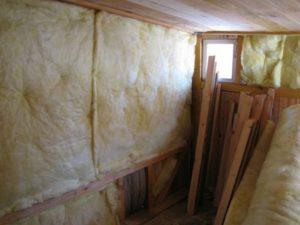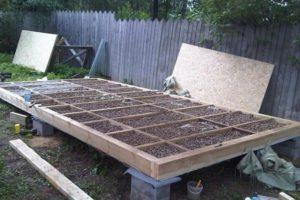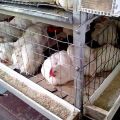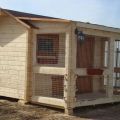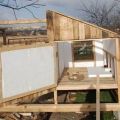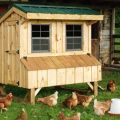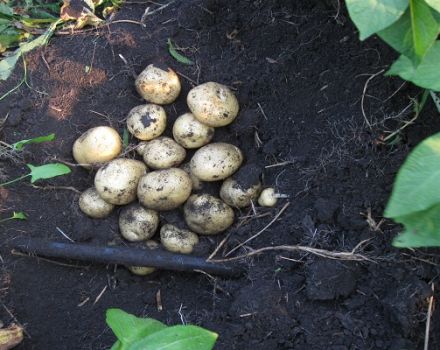How to build a chicken coop for 20 chickens with your own hands, dimensions and drawings
Breeding poultry on the site is popular among summer residents, as it is affordable, and eggs and chicken meat are in demand on the market. In addition, it is not so difficult to breed a chicken, and you can create a chicken coop yourself, with the knowledge and construction experience. Let's figure out how to build a chicken coop for 20 chickens with our own hands and how to properly equip it inside.
The optimal size of the chicken coop
The dimensions of the future premises should be selected based on the optimal placement of the livestock and the convenience of its maintenance.
Area and dimensions
One square meter should fit two to four chickens or three to four broilers. The minimum area for a chicken coop for 15-20 birds should be approximately eight to ten square meters for meat and egg breeds or five to seven squares for broilers. It is better to make the shape of the chicken coop rectangular, elongated, so that it can be removed without going inside.
House height
For a comfortable stay of roosters and layers, as a rule, a height of one and a half meters is sufficient. However, when building, you should consider the convenience of cleaning the room. Therefore, poultry houses are often made higher - so that it is convenient for a person to be inside.
No overlap
If you plan to build a chicken coop without overlap, the walls should be erected one and a half meters high. The roof is constructed with two slopes. The ridge rises two meters or more. You can stay inside such a chicken coop without any problems. However, you will have to get out carefully, as there is a risk of seriously hitting your head on the sloping roof.

With an attic
In this version, the walls should be driven out to the height necessary for free movement inside the building, that is, a couple of decimeters higher than human height. In this case, the overlap, floor and bedding must be taken into account. They will take a total of 45-50 centimeters in height. A poultry house with an attic will require more insulation material, but it is possible not to insulate the attic, but only the ceiling itself.
On the pillars
We dig four beams in the corners of the future chicken coop, build the floor at a height of half a meter to eighty centimeters from the ground level, put the roof at a height of two meters. This option is more suitable for the summer season, but it can be insulated.
Projects and drawings
During construction, you can rely on ready-made drawings, calculated taking into account all norms.
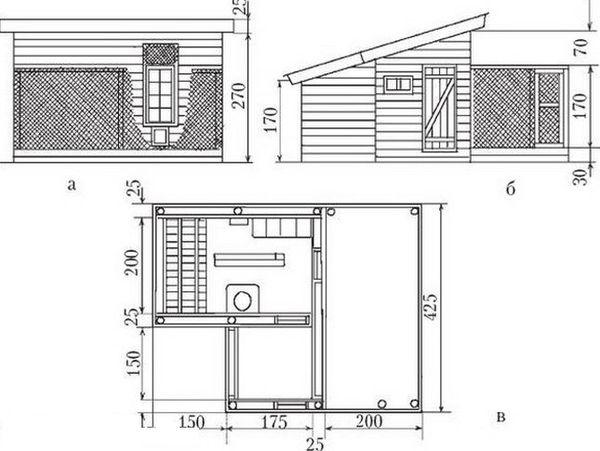
Location of the chicken coop
The building site should not flood and accumulate liquid. If the soil on the site is prone to moisture accumulation, it must be drained. It is best to locate the building on a slope or hill. It is good if the slope is on the southeast side. This will provide the birds with good lighting. At the same time, you should not build a poultry house near the roadway, as the noise generated by cars will negatively affect the general well-being of the birds, which will worsen the quality of eggs and meat.
Materials and tools for construction
You will need concrete mortar to fill the foundation of the house. For the frame, you need wooden beams and boards. Plywood sheets are required for interior cladding. The roof of the chicken coop is built of roofing material or slate. You will need a mesh and metal clamps to fence off the patio.
From the tools you will need a trowel, a plane, an ax, as well as a tape measure and a building level.
Stages of building a chicken coop
The construction of a chicken coop is divided into several stages: laying the foundation, building walls and floors, erecting a roof and a ceiling, installing doors and windows, insulation and interior arrangement of the room.

Foundation
Construction should begin with laying the foundation.
Columnar
The foundation for the future structure can be built from bricks. For marking, we drive in wooden pegs and tighten them with a rope, checking its horizontal position with a level. Then we remove a layer of earth with a thickness of two decimeters. In the corners and perimeter, we dig eight holes for the pillars.
The bottom is covered with gravel or sand. Two bricks are laid in the holes. They are covered with cement and two more bricks are placed on top. We put a curbstone up to the level of the rope. Finished posts are processed with mastic.
Tape
To lay the foundation with a tape method, you will need building blocks, bricks or wood concrete. A trench half-meter deep and 35-40 centimeters wide is dug along the perimeter of the base. The bottom is cleared, compacted, covered with rubble. A layer of construction sand is poured and compacted on top.
Formwork is made from the boards, so that the shields rise by at least ten centimeters. Reinforcement is laid inside the foundation - to increase the stability of the structure. Two rods are enough, they should be fifteen centimeters apart from each other.
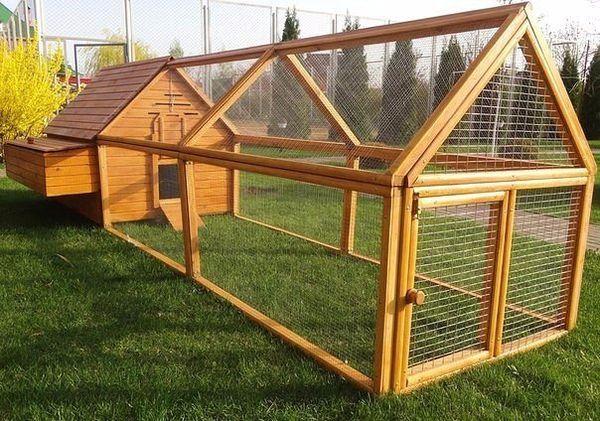
After all the preparations, concrete is poured. Align the top layer and leave it for three weeks. Then we remove the formwork and start building the walls.
Erection of walls and floors
To install the walls, you need to make a frame and clog it with layers of a mixture of clay and straw. The frame structure can be made from an iron corner. In the walls, you need to create door and window openings and an opening for the egg box. Planks of half a meter are laid on the floor in two layers.
Roof and ceiling
It is recommended to build a gable roof so that it retains heat better. The frame is made of lathing and rafter legs. The frame cladding is made of materials with low thermal conductivity. You can cover the roof with roofing material or metal.
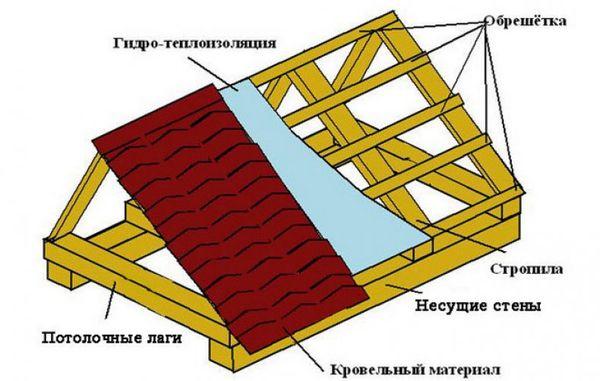
Doors and windows
Windows and doors are thought out in the hen house in advance, even at the stage of preparing the wall frame. Windows must be covered with metal mesh to protect against predators.
Insulation of the chicken coop
Straw, shavings with sawdust, moss peat are suitable as floor insulation. The litter should be deep to create the right temperature in the room. Wall insulation is chosen depending on the material from which the walls are built. Walls should be insulated on both sides.
Features of the arrangement of the poultry house
The chicken coop is equipped from the inside in such a way as to provide the chickens with the most comfortable conditions under which they will regularly produce eggs. In addition, it should be convenient for a person to be in the chicken coop, since you regularly have to fill the feeders and clean up.
Feeders and drinkers
Feeders should be large and comfortable. The size is selected so that all the birds have enough space while eating. Automatic hopper feeders are popular as they pass feed as needed.
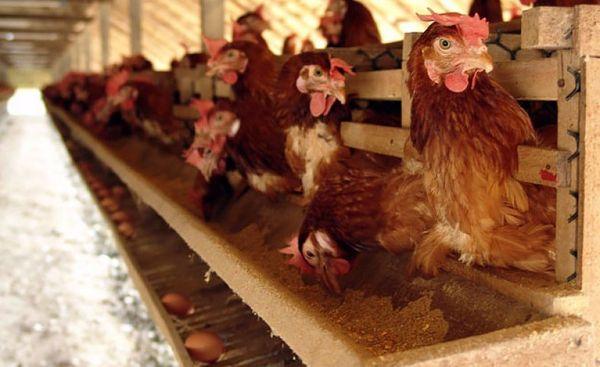
Perches
Chickens love to roost, so it also needs to be equipped. The length is selected based on the number of birds. For an adult laying hen - twenty to twenty-five centimeters, for a chicken - fifteen centimeters. If necessary, you can equip several perches. They should be equipped in such a way that the gap between them is at least thirty centimeters.
Litter
The litter is made from sawdust, straw dust, corn cobs, peat. The thickness of the bedding layer is from twenty centimeters. Hay can be used instead of straw and corn. In summer, the underlying surface layer may be less. The litter is completely changed at least every five months.
Nests
Plywood or boards are suitable as material for creating nests. Nests can be mounted or separate.
For suspended structures, special attention should be paid to the strength of the fasteners.
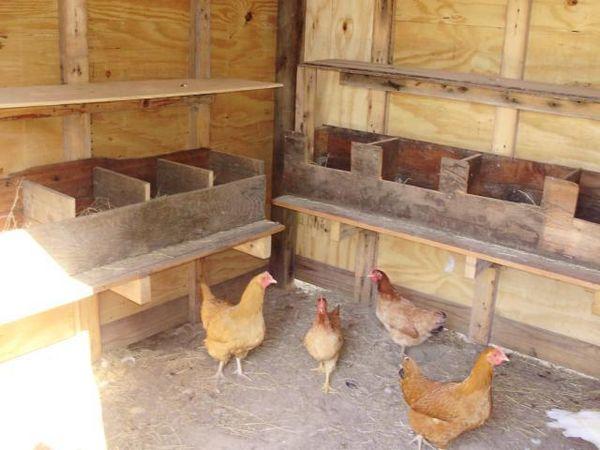
Ventilation arrangement
Ventilation is required in the room, it should be provided even at the construction stage. The openings can be in the form of small windows, which, together with the windows, will provide additional daylight.
Lighting
Infrared lamps are suitable for lighting the house. In addition to light, they give warmth to the hen house. However, the lamps should not be lit around the clock. For the health of chickens, it is necessary to provide them with light for fourteen hours a day.
Heating system installation
Chickens do not tolerate low temperatures well, so the chicken coop must be insulated. Without high-quality heating, the bird will not be able to winter. In most cases, additional heating is mandatory, especially in northern regions where winter temperatures are kept low for extended periods of time.
With sawdust
To insulate the walls, they are putty with sawdust and clay. In this case, it is necessary to observe the correct proportions: the amount of sawdust and clay should be in a ratio of three to two. The clay must be soaked in water and stirred until smooth, and then mixed with sawdust. The mortar is applied to the wall in a layer three centimeters thick. After drying, the walls are covered with lime.
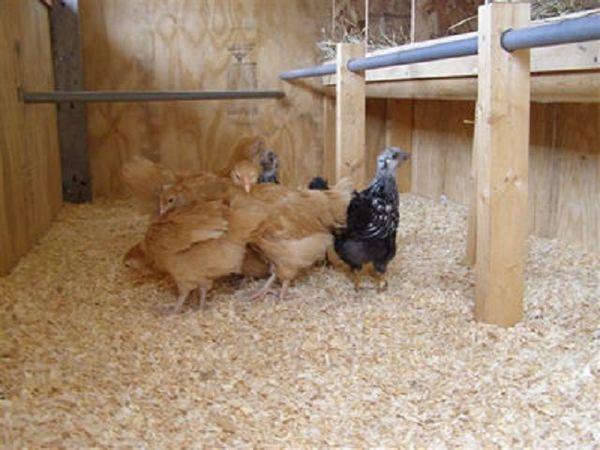
With a boiler and a potbelly stove
The easiest way to heat a chicken coop in winter is to use a heating stove. It consists of a boiler and a chimney. Such a system does not require special maintenance, and almost any non-toxic material can be used as fuel for it.
Infrared lamps
The infrared heater works by the method of electromagnetic radiation. It consists of a body, emitter and reflector. For its operation, only the presence of electricity in the room is required.
Walking yard
Birds need regular exposure to fresh air for health. It is necessary to equip the chicken coop with an aviary of the maximum area that you can afford. For twenty birds, at least sixteen square meters of space will be required. It is better to make an aviary indoor, since many chicken breeds are able to jump over a high fence.
